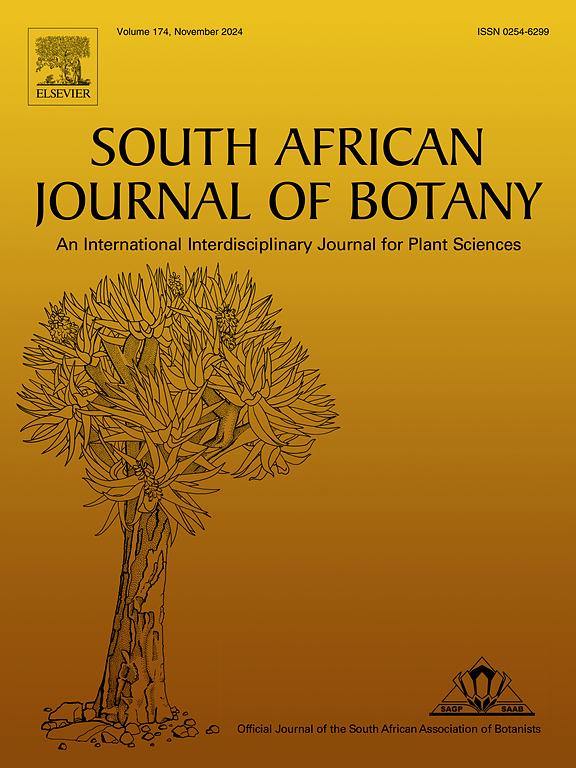Production of elicitor-induced phytochemicals in callus and shoot cultures of Hypericum heterophyllum
IF 2.7
3区 生物学
Q2 PLANT SCIENCES
引用次数: 0
Abstract
In the present study, it was objected to determine the rapid in vitro propagation of the endemic Hypericum heterophyllum, and the effects of abscisic acid (ABA) and salicylic acid (SA) applications on the production of bioactive compounds in tissue culture. Total phenolic (TP), 2,2-Diphenyl-1-picrylhydrazyl (DPPH), and High Performance Liquid Chromatography (HPLC) analyses were carried out in both in vivo plants and in vitro samples. Initially, seeds were objected to pre-treatment with 1.5 mg/L GA3 for 48 h, then surface-sterilized with 15 % NaOCl and germinated at Linsmaier and Skoog (LS) medium containing Gamborg's B5 vitamins without plant growth regulators. After germination, axillary buds were used as explant for callus and shoot regeneration. Full-strength LS medium with B5 vitamins, 0.5 mg/L thidiazuron (TDZ) and 0.5 mg/L indole butyric acid (IBA) gave the highest ratio (73.3 %) of green and fragile callus formation. On the other hand, the highest shoot regeneration (86.7 %) was obtained from LS/B5vit with 1 mg/L benzylaminopurine (BAP). Elongated shoots were rooted in a medium containing 1.5 mg/L IBA after 8 weeks and in vitro plantlets were obtained for elicitation. Then, calli and in vitro plantlets were exposed to 0.01, 0.05 and 0.1 mg/L ABA or SA elicitors in LS/B5 medium for 15 days, separately. Total phenolic content was higher in the in vivo plant leaves (77.6 mg GAE/g) than flower, stem and herb. In in vitro grown plantlets, the highest total phenolic content (37.04 mg GAE/g) was obtained from the control without ABA and SA application. On the other hand, 0.01 mg/L ABA application resulted in the highest total phenolic content (29.5 mg GAE/g) in callus cultures. The highest DPPH activity was achieved in vivo leaf (415.8 mg TEs/g extract), with 0.01 mg/L SA application in vitro plantlets (84.4 mg TEs/g extract) and with the use of 0.05 mg/L ABA in callus (136.3 mg TEs/g extract). In addition, chlorogenic acid, hyperoside, catechin, quercetin, kaempferol, and apigenin were determined with HPLC analysis. The main compound was chlorogenic acid (5.8 mg/g DW) in vivo leaves, followed by hyperoside (3.2 mg/g DW) in the same plant part, and lastly, quercetin (0.58 mg/g DW) had the highest amount in herba. The value of hyperoside was 0.28 mg/g DW at 0.01 mg/L ABA in in vitro plantlets; meanwhile 0.01 mg/L SA application produced 0.49 mg/g DW in calli. With regard to quercetin, it had the highest value at 0.1 mg/L SA (0.29 mg/g DW) in calli, comperatively, 11.2-fold more than the control (0.026 mg/g DW) group. The catechin content varied within a very wide range, from 0.025 to 0.23 mg/catechin g DW in callus. Elicitation with 0.01 mg/L ABA significantly enhanced the production of quercetin, catechin and hyperoside in both in vitro plantlets and calli.
求助全文
约1分钟内获得全文
求助全文
来源期刊

South African Journal of Botany
生物-植物科学
CiteScore
5.20
自引率
9.70%
发文量
709
审稿时长
61 days
期刊介绍:
The South African Journal of Botany publishes original papers that deal with the classification, biodiversity, morphology, physiology, molecular biology, ecology, biotechnology, ethnobotany and other botanically related aspects of species that are of importance to southern Africa. Manuscripts dealing with significant new findings on other species of the world and general botanical principles will also be considered and are encouraged.
 求助内容:
求助内容: 应助结果提醒方式:
应助结果提醒方式:


